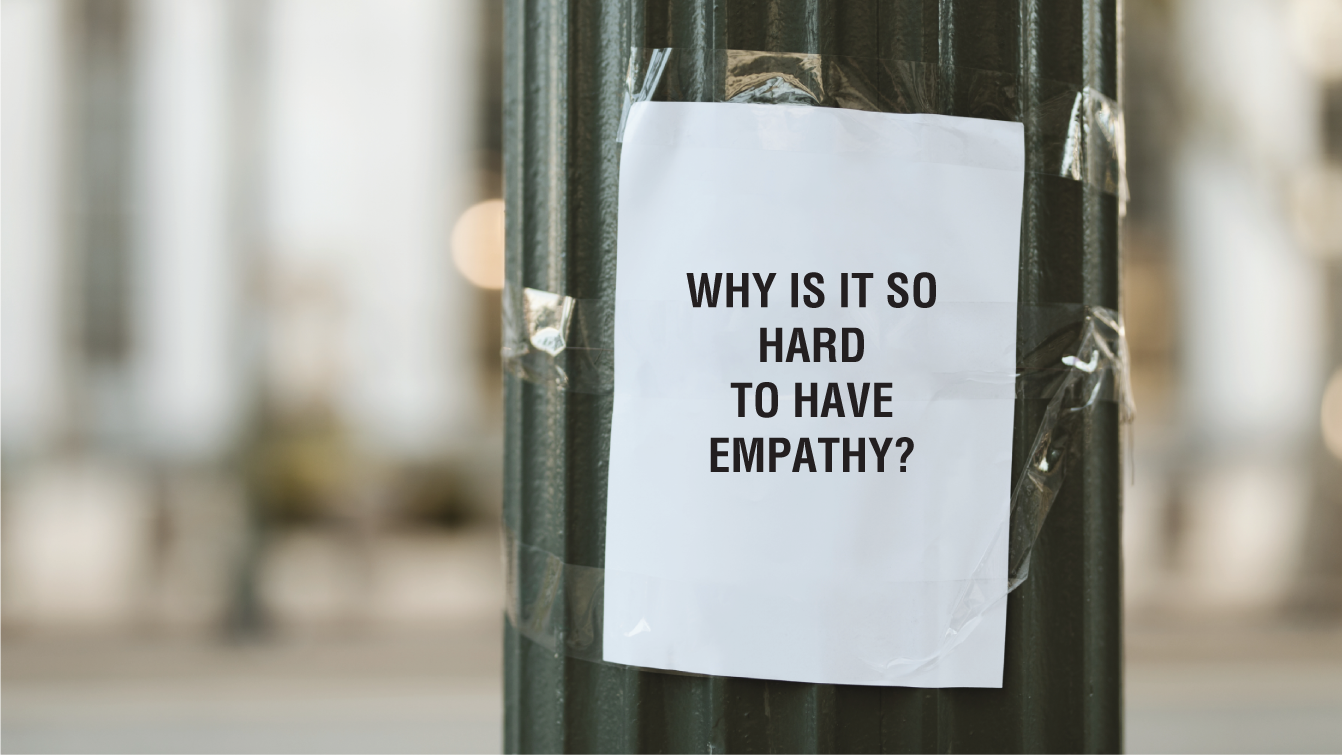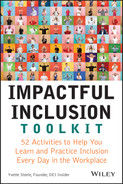ACTIVITY 37
Go Beyond Performative Gestures
“Actions speak louder than words.”
—Proverb
***
When what we say and do in public is incongruent with what we say and do in private, it is considered performative and hypocritical. Social movements like #MeToo, Black Lives Matter, Gay Rights, or Stop Asian Hate tend to reduce us to performers and hypocrites when we want to be perceived as caring about justice and equality for marginalized groups. But wouldn't it be easier to just be authentic than be discovered a fraud? For many individuals and organizations alike, the answer is absolutely not! The pressure may be too intense. Perhaps there's guilt in not caring or we just want to jump on the bandwagon and get congratulated for being there. The last thing we want is for others to believe or suspect us to be racist, sexist, homophobic, transphobic, or xenophobic, especially when it takes minimal effort and no commitment to equality and justice to showcase a Pride mug or other symbolic gesture on our desks to assuage the guilt and pressure. In doing so, we get to feel better about ourselves and reassure our marginalized co-workers or staff that we're one of the good ones. In essence, we're saying “I am on your side. I support you,” without having uttered a word. The truth is that symbolic gestures never equate to action (See figure 37.1). They are just words and symbols masquerading as support, and eventually people will discover the truth. How will one respond if ever called on to back up those signals of support? A post by PsychologicalScience.org shares,
The post continues,

Figure 37.1 Symbolism is not enough.
That said, rather than waste so much energy in pretending to stand for equal rights, opting to do nothing may be a close second. That way, we're not standing for or against, and we get to enjoy the comfort of the neutral zone. Spoiler alert: doing nothing is doing something—it condones and perpetuates the very systems and behaviors that need to be changed (See figure 37.2).

Figure 37.2 Become part of the solution.
People label themselves an ally in acts of performative allyship and believe that they can skip doing the actual work. I've never seen where the label matches the sentiment in absence of the work. When we're not using gender-neutral language in mixed groups, recognizing and calling out microaggressions, or engaging in conversations on polarizing topics and so on, we are not doing the work but engaging in performative and symbolic gestures that miss the mark by a long shot. Folks may argue that the symbolism serves as a reminder of their allegiance and a call to be prepared when they see something or when asked for help. That's like preparing for an exam by merely looking at the study materials—totally ineffective. Individuals from marginalized groups are well aware of the long history of the dominant culture calling themselves allies and yet have nothing to show for their alleged support; or worse, the supposed allies are continuing to inflict harm. Millions donned a safety pin as a symbol of support for underrepresented groups amid the Donald Trump campaign and subsequent election to represent allyship. The campaign message was a direct threat to the health, safety, and well-being of Black and Brown Americans, and wearing the pin signaled “safety” and support for people of color as well as a willingness to stand up if and when needed. As of this writing in 2022, I don't see the pins anymore. What symbol should marginalized groups now look for? Unless you're doing the work, you can't be identified and won't be considered an ally. The election of Joe Biden did not eradicate inequitable systems and institutions, and the threat persists as long as there is racism and prejudice. There's still much to be done. Moving past performative allyship means asking, “How can I show that I stand for justice and equality in an authentic, impactful, and accountable way?” Actions speak louder than words, and words and actions must be in sync, especially in these divisive times. Wearing the “Black Lives Matter” or “Stop Asian Hate” T-shirt, displaying a Pride flag at your workstation, or posting your sentiments about injustice on social media are all great ways to raise awareness, but being aware of a problem won't solve it. Awareness is only the beginning. Social movements exist for a reason: to help disrupt systems of oppression, discrimination, and prejudice. Effective allies must first acknowledge that inequalities exist and the role they play in perpetuating them and then find the courage to shift from perpetuating the problem to eradicating the problem. We must come to terms with the fact that each of us is in a position to drive change. Everybody can do something in one way or another to varying degrees. The more power and privilege one has, the better the impact to be made. While some may be in a position to lobby for gay rights, others are able to provide financial support from a few dollars to thousands of dollars to nonprofit organizations that support gay rights. While some of us are in a position to hire and promote deserving and qualified individuals from historically excluded groups, others can mentor or sponsor them, while still others can connect, recommend, and write referrals for jobs, scholarships, and more. Champions of inclusion endeavor toward tangible and lasting change that improves lives and ultimately systems and culture. We acknowledge our privilege and use it for the greater good, rather than personal gain. True allyship is a verb. It's intentional, proactive action with consistency. Starting with individual actions helps in learning the issues and honing skills. I find this to be the comfort zone for many. Others may be visionaries and innovators who can institute collective action and cultural shifts. Changes in systems and institutions can accelerate as members of the dominant culture work to stimulate rather than stymie transformation, especially in those areas that members of the minority culture can't access due to lack of power and privilege. It's essential to face the fear in making the first step and taking it anyway. The fear dissipates over time. Active allyship is an ongoing journey toward diversity, equity, inclusion, belonging, and justice for marginalized communities, thus making the workplace better for all, as well as society as a whole.
Actions
Be Real with Yourself
Our hypocrisy enables us to fool folks for a short time, but we can never fool ourselves. Performative allyship is not allyship but a fragile façade. No one truly benefits from hashtags, slogans, and symbolic memorabilia. We must decide whether we are in or out of active allyship. There is no neutral. Just realize that being out means we are condoning or, worse, perpetuating systems of oppression and discrimination.
Learn to Recognize Personal Biases and Racist Tendencies
I know, I know. Everyone is biased, and no one admits to being racist. However, racism and bias exist every day both inside and outside the workplace. Our culture is embedded with discriminatory practices against anyone who is not cisgendered, white, male, heterosexual, and able bodied; thus, all of us are capable of racist or prejudicial behavior. Many of us are oblivious to it, especially when we are the culprits. Nevertheless, everyone has a role in creating safe and inclusive environments, and as allies advocating and fighting for equity, the work begins on a personal level. Review Activities 1, 2, 3, 12, and 13 for guidance. The greatest hypocrites are those who call out others for the very actions they commit themselves. Checking for our biases and intervening when racism or oppression occurs in the workplace requires educating ourselves about ourselves. Further, learning how racism and inequality shows up is essential if we are to be effective. We must realize how our beliefs and tendencies impact not only people of color but also where people intersect, i.e., an Asian, bisexual female. In this intersection of identities, an Asian male would naturally advocate for other Asians but may discriminate against a queer, Asian female.
Move from a Place of Comfort to Growth
Performative allyship is a place of comfort. There is no risk, no commitment, and no action—only words and symbolic gestures. However, I'm willing to bet that since you made it this far in the book, you are well-intentioned, open-minded, courageous, ready to learn, and socially conscious. We must now embrace the discomfort or inertia that we've deflected for so long so that growth can begin. This may require moving past guilt and fragility for most, while for others it's about learning to leverage the privilege you have. Everyone has some level of privilege that can help someone else. Moving from comfort to growth won't be linear; there will be setbacks, and that's okay as long as we get up and get back out there. Exposure to ambiguity and volatility in this space scares the heck out of folks, so anticipate it, build resilience, and eventually, you'll thrive in it. It's how allies become effective.
Review allyship steps and considerations to move from performative to active:
ncaaorg.s3.amazonaws.com/ncaa/programs/a4/LD_A4Allyship.pdfwww.ubs.com/global/en/assetmanagement/insights/thematic-viewpoints/sustainable-impact-investing/articles/what-does-it-take-to-be-an-ally/_jcr_content/mainpar/toplevelgrid/col1/innergrid_1475432314/xcol2/textimage_377377446.1742344515.file/PS9jb250ZW50L2RhbS9hc3NldHMvYW0vZ2xvYmFsL2luc2lnaHRzL3dlYmluYXIvaW1nL2FsbHlzaGlwLnBuZw==/allyship.pngf
Action Accelerators
- JenniferBrownSpeaks: Podcast: E113, “Pain and Possibility, How Dr. Maysa Akbar is Charting What's Beyond Allyship”:
willtochange.libsyn.com/e113-pain-and-possibility-how-dr-maysa-akbar-is-charting-whats-beyond-allyship Ginger.com: “Beginner's Mindset: How to Learn & Grow as an Ally” by Elissa Burdick:www.ginger.com/blog/beginners-mindset-how-to-learn-grow-as-an-allyYouTube.com: Black lives don't need performative allies, Déjà Rollins, TEDxUAMonticello:www.youtube.com/watch?v=U5DU0fqF9UoYouTube.com: Listen, Learn, & Speak Up: Allyship & Activism, Chiara Lea, TEDxBrentwoodCollegeSchool:www.youtube.com/watch?v=ec7aIpo9yJIYouTube.com: A guide to lifelong allyship, Catherine Hernandez, TEDxToronto:www.youtube.com/watch?v=g3D-5-2EqHI
Sources Cited
- PsychologicalScience.org. “We Dislike Hypocrites Because They Deceive Us,” January 30, 2017,
www.psychologicalscience.org/news/releases/we-dislike-hypocrites-because-they-deceive-us.html
